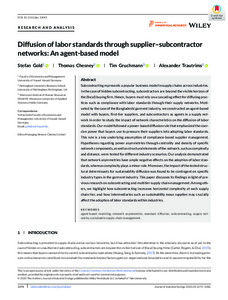| dc.date.accessioned | 2020-12-08T09:41:37Z | |
| dc.date.available | 2020-12-08T09:41:37Z | |
| dc.date.issued | 2020-06-22 | |
| dc.identifier | doi:10.17170/kobra-202011182203 | |
| dc.identifier.uri | http://hdl.handle.net/123456789/12115 | |
| dc.description.sponsorship | Gefördert im Rahmen des Projekts DEAL | ger |
| dc.language.iso | eng | eng |
| dc.rights | Namensnennung-Nicht-kommerziell 4.0 International | * |
| dc.rights.uri | http://creativecommons.org/licenses/by-nc/4.0/ | * |
| dc.subject | agent-based modeling | eng |
| dc.subject | network asymmetries | eng |
| dc.subject | standard diffusion | eng |
| dc.subject | subcontracting | eng |
| dc.subject | supply networks | eng |
| dc.subject | sustainable supply chain management | eng |
| dc.subject.ddc | 330 | |
| dc.title | Diffusion of labor standards through supplier–subcontractor networks: An agent‐based model | eng |
| dc.type | Aufsatz | |
| dcterms.abstract | Subcontracting represents a popular business model in supply chains across industries. In the case of hidden subcontracting, subcontractors are beyond the visible horizon of the (focal) buying firm. Hence, buyers must rely on a cascading effect for diffusing practices such as compliance with labor standards through their supply networks. Motivated by the case of the Bangladeshi garment industry, we constructed an agent‐based model with buyers, first‐tier suppliers, and subcontractors as agents in a supply network in order to study the impact of network characteristics on the diffusion of labor standards. Our model followed a power‐based diffusion rule that emphasized the coercive power that buyers use to pressure their suppliers into adopting labor standards. This rule is a key underlying assumption of compliance‐based supplier management. Hypotheses regarding power asymmetries through centrality and density of specific network components, as well as structural elements of the network, such as complexity and distance, were tested for different industry scenarios. Our analysis demonstrated that network asymmetries have ample negative effects on the adoption of labor standards, whereas complexity plays a minor role. Moreover, the impact of the tested structural determinants for sustainability diffusion was found to be contingent on specific industry types in the garment industry. This paper discusses its findings in light of previous research on subcontracting and multitier supply chain management. Among others, we highlight how subcontracting increases horizontal complexity at each supply chain tier, and how intermediaries such as sustainability nexus suppliers may crucially affect the adoption of labor standards within industries. | eng |
| dcterms.accessRights | open access | |
| dcterms.creator | Gold, Stefan | |
| dcterms.creator | Chesney, Thomas | |
| dcterms.creator | Gruchmann, Tim | |
| dcterms.creator | Trautrims, Alexander | |
| dc.relation.doi | doi:10.1111/jiec.13041 | |
| dc.subject.swd | Agent <Informatik> | ger |
| dc.subject.swd | Modellierung | ger |
| dc.subject.swd | Zulieferindustrie | ger |
| dc.subject.swd | Subunternehmer | ger |
| dc.subject.swd | Supply Chain Management | ger |
| dc.subject.swd | Nachhaltigkeit | ger |
| dc.type.version | publishedVersion | |
| dcterms.source.identifier | EISSN 1530-9290 | |
| dcterms.source.issue | Issue 6 | |
| dcterms.source.journal | Journal of Industrial Ecology | eng |
| dcterms.source.pageinfo | 1274-1286 | |
| dcterms.source.volume | Volume 24 | |
| kup.iskup | false | |


